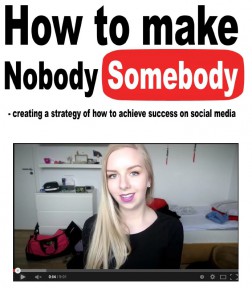Denne opgave forsøger at finde ud af hvad der skal til for at gøre en ung YouTuber til en micro-celebrity inden for feltet skønhed og makeup på YouTube. Derudover forsøges der at besvare hvordan en guideline i form af en social mediestrategi kan hjælpe med at opnå symbolsk kapital. Denne sociale mediestrategi bliver testet i et fire ugers eksperiment hvor den testes i samarbejde med en target case. I dette eksperiment er der fundet diverse faktorer der spiller ind, hvis man vil opnå symbolsk kapital og dermed komme nærmere målet at blive en micro-celebrity. Der er to faktorer der kan karakteriseres ved Bourdieus begreber kulturel og social kapital. I forhold til social kapital er der en tæt beslægtning med begrebet kritisk masse, hvor enten tid eller størrelsen på det sociale netværk er af afgørende betydning for at opnå kritisk masse og i sidste ende symbolsk kapital. Denne sociale kapital skal akkompagneres med en tilstrækkelig mængde kulturel kapital i form af viden og tekniske evner om hvordan en YouTuber skal begå sig på de sociale medier, hvilket beskrives af den sociale mediestrategi. Derudover er der to menneskelige faktorer der er essentielle for at blive en micro-celebrity på YouTube. Motivationen til at følge strategien der karakteriseres ved menneskets frie vilje og x-faktor i forhold til personlighed og evnen til at differentiere sig blandt andre YouTube-kanaler.
Indledning
The Information Age is a period in human history set off by the Digital Revolution and the introduction of the internet. Manuel Castells’ theory of “The Network Society” explains how the Information Age is not a technological matter, but a social transformation in which technology is an element that is inseparable from social, economical, cultural and political trends (Bell, 2007). Castells argues that culture is mediated and enacted through communication – so if communication changes, so does culture (ibid). This means that the introduction of a new communication media – the internet – has changed culture and how individuals behave. The introduction of the internet has offered new platforms for individuals to produce and consume, which mediates reflections of self-identity (ibid). The Network Society presents a new way for individuals to get socialized and creating identity online (ibid). Along with the idea of creating identity online comes the idea of self-presentation and how to manage it.
In the mid-90’s self-presentation happened on personal homepage through a media which facilitated the reflective self (Cheung, 2000). Before the internet self-presentation was something that happened live when meeting other persons where factors such as first impression was important. The introduction of the internet resulted in homepages with the opportunity of greater control with which sides of the self to present (ibid). The homepages contained information such as favorite food, interests and background information – a classic characteristic for these early homepages (ibid). These homepages were the first steps towards social media and a personal identity online. Social media is now an essential part of daily life and as Castells (Bell, 2007) points out also a huge part of creating identity. According to Giddens (Kaspersen, 2007) the creating of self-identity in the ultra-modern society is a reflective project that each individual is responsible for – we are what we make us. Before the ultra-modern society it was external conditions and traditions that defined the identity. Today life has become a question of making decisions constantly to maintain the self-presentation (ibid). So the creation and maintaining of self-identity has become a lifelong project.
As Castells (Bell, 2007) points out; a change in communication results in a change of culture which happened with the introduction of social network sites. Consequently people started changing behavior online as an effect of the change in communication which affected culture by making it common to have profiles online e.g. via Facebook or MySpace (ibid). The focus shifted and was not only on self-presentation but also about interacting with other people online (Cheung, 2000). It enabled the users of e.g. Facebook to build and maintain social networks and relations among people who share the same interests, activities or background. It was the introduction of Web 2.0 that made it possible to negotiate the online self-presentation with the feature of not only reading but also writing (O’Reilly, 2005). In other words it became possible to interact with other people via social media. The way social media are different from each other is what Meyrowitz (1997) describes as ‘the unique grammar of media’ which is the framework and characteristics that all (social) media have. YouTube for instance has its own unique grammar in uploading user generated videos, with a title and a description. Besides that YouTube gives the viewer the opportunity to subscribe, rate and comment. When being successful in using the unique grammar of social media one can become an ‘internet celebrity’.
Internet celebrities (micro-celebrities) use the power of social media to become famous for making fun of themselves, exposing their talent such as singing or instructing girls on how to make the perfect look with makeup etc. This can be done on e.g. YouTube with so-called ‘Haul videos’ where micro-celebrities can gain a lot of views, likes and people who follows them. It makes micro-celebrities very influential people who have created a high amount of ‘social capital’. Social capital is a value, on equal terms as economic capital that is created in social relations and can be exchanged to other forms of capital (Bourdieu, 1986). Social capital can be converted to power in a social network – power to promote and power to influence a target group. With a large social network comes the power to send out a message that has the possibility to be seen by a lot of people.
Haul videos are a fast growing trend with amateur people who presents trends and tutorials on YouTube. Haul videos are recordings where a person present or display items recently purchased (Joel 2010). Haul videos have become a launch pad for young girls to become micro-celebrities and a possible way for them to make a livelihood (Halperin, 2014). These micro-celebrities can become influential trendsetters that might end up in favorable deals with related companies or contracts with distributors e.g. YouTube. These contracts are about making video contributions on a regular basis promoting themselves and/or products. In that sense self-presentation and self-promotion converges as the presentation of an online identity becomes part of a business in promoting both products and the person itself through these Haul videos.
The focus is to investigate how it is possible to take advances of the social media and their framework in order to get success on social media – in other words to obtain symbolic capital. The micro-celebrities who run a YouTube-channel have social and cultural capital, and the goal for this study is to develop a ‘social media strategy’ to obtain these capitals. To develop a social media strategy, one needs to understand how to use these social media to its fullest potential. Knowledge about how micro-celebrities achieve success on YouTube can be obtained by using ‘media grammar literacy’ (Meyrowitz, 1997) and in order to utilize each social media’s framework ‘medium literacy’ needs to be understood (ibid).
This investigation will try to understand social media and its unique features in order to achieve symbolic capital. The synergy between the different social media in the strategy, and how they complements each other, is also a matter in this investigation. This research tries to develop essential guidelines for self-promotion on social media.

